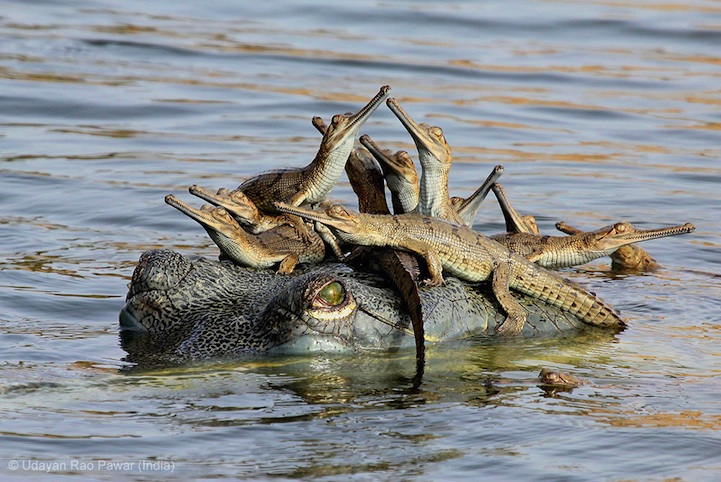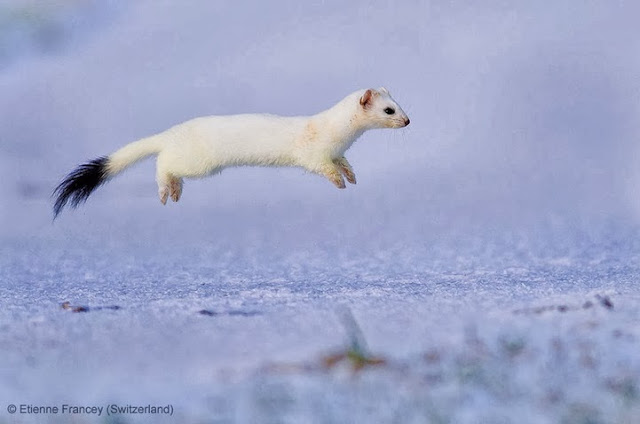What an awe-inspiring
sight! A few days ago, on Friday, November 29, The Grand Canyon was taken over
by a rare weather phenomenon that filled the entire canyon with a thick layer
of fog. The occurrence, called a temperature inversion, caused everyone, including
rangers, to flock to the rim to take photos of it. As the Grand Canyon National
Park Facebook page stated, "Rangers wait for years to see it. Word spread
like wildfire and most ran to the rim to photograph it. What a fantastic treat
for all!"
Wednesday, 4 December 2013
Sunday, 1 December 2013
Amazing Image of Sydney Through A Glass
Indeed this is very creative capture by Daniel Roberts, we see part of the iconic Sydney skyline reflected in a Kirribilli wine glass. Along with the popular Sydney Opera House you can also see the RMS Queen Mary 2. The optic phenomenon that is causing the image to flip upside down is known as refraction. To learn more about refraction check out thisWikipedia entry.
Floating Biodome Absorbs Carbon Dioxide, Emits Oxygen
The Bloom is a futuristic take on
marine farming designed by French firm Sitbon Architectes that was chosen as
one of 5 finalists for the first Architizer A+ Awards in the "architecture
and weather" category. The spherical structure is well designed to be a
semi-submersible laboratory garden, cultivating microscopic marine organisms famous
as phytoplankton that produce oxygen and aid in plummeting the carbon dioxide
in the atmosphere. The floating structure is espically designed to be tethered
to the seabed by a series of cables and uses an advanced filtration system to
make salt-water into fresh-water for the onboard residents. An everlasting
staff of researchers, scientists, and marine biologists would live aboard the
vessel, screening the ongoing experiments and using the phytoplankton farms to
lower carbon-dioxide levels in areas of requires across the globe. Bloom would
also be able to detect infinitesimal changes in the surrounding waters to assist
alert nearby nations of impending tsunamis. Eventually, the goal of the project
is to address both global warming and the rapidly rising sea-levels.
Unbelievable Light Painting Portrait in Seoul Korea
As part of this year's in recent
times wrapped National Geographic Photo Contest, photographer Sungjin Kim
entered this incredible light painting portrait. Like As we have seen a few
times before, a piece of steel wool was spun to produce a brilliant cascade of
sparks. Love how this was taken right in the middle of a busy metropolitan city
and how the light painting effect is intensified by the reflection in the
water. This is one of best picture I ever see.Playing with fire beside the
canal in the modern city. Songdo, South Korea
Photo and caption by Sungjin Kim/National Geographic Photo
Contest
Wednesday, 27 November 2013
Russian peninsula of Kamchatka is a land of volcanoes
The Russian peninsula of Kamchatka is a land of volcanoes. During my journey there between October 14 to 26, 2013, I visited the active volcanoes Klyuchevskoy and Sheveluch. The former erupted for the first time in three years. During its strongest eruptive phase (shown above), lava fountains rose up to 0.6 mi (1 kilometer) above the summit dome, and explosions could be heard at a distance of 19 mi (30 kilometer) away. Note the funnel shaped cloud of steam and smoke more than Klyuchevskoy's concealed, volcanic cone. picture taken on October 16, 2013, at a distance of approximately 9.5 mi (15 km).
Photographer: Marc Szeglat; Marc's Web site
Author Summary: Marc Szeglat
Photo details: Camera Maker: Panasonic; Camera Model: DMC-GH3; Focal Length: 35.0mm (35mm equivalent: 70mm); Aperture: f/2.8; Exposure Time: 3.200 s; ISO equiv: 500.
Saturday, 23 November 2013
The Richat Structure, Mauritania
The Richat Structure is famous for mysterious
Eye of Africa. The structure, situated in central Mauritania, was first
discovered by astronauts on early space missions. The formation is around 30
miles in diameter. The first theory of its origin implied that it formed as a
result of a meteorite hitting the Earth. Although in more modern theories, the
uplift is supposed to be the result of erosion. Researchers have yet failed to
explain the circular form of the structure.
Friday, 8 November 2013
Eclipse at 44,000 Feet
Flying at 44,000 feet (13,000 meters), eclipse chasers on a chartered jet managed to intercept the Moon's shadow over the Atlantic Ocean during the November 3, 2013, solar eclipse. The remarkable flight made a perpendicular crossing of the central shadow track. The photograph below was taken by Ben Cooper of Launch Photography.
Labels:
Science
Unseen Sea HD Video from Simon Christen
This is the most beautiful video ever made by Simon Christen. Yes this is amazing! There are quite some timelapse videos going around
on the web. And I can't get enough of it.. This one is one of the better
I've seen.
The Unseen Sea from Simon Christen on Vimeo.
The Unseen Sea from Simon Christen on Vimeo.
Labels:
Travel
Thursday, 31 October 2013
Thursday, 17 October 2013
Winners of the Wildlife Photographer of the Year 2013
- Winners of the Wildlife Photographer of the Year 2013
2013: Young Wildlife Photographer of the Year - Grand Title Winner
The shortlist includes hundred images
that are first separated into two age groups, Adult and Young and then
by category wise, Animal Portraits, Underwater World and Creative
Vision. Out of all those images, here were the top 18 images.
Mother’s Little Headful Photo: Udayan Rao Pawar (India)
Winners
of the prestigious Wildlife Photographer of the Year competition were
just announced where more than 43,000 images from 96 countries were
whittled down to just 18. Now in its 49th year, the competition
showcases the very most excellent in nature photography and is led by
two UK institutions, the Natural History Museum and BBC Worldwide.
Winners of the Wildlife Photographer of the Year 2013
2013: 15-17 Years - Winner
Last LightPhoto: Mateusz Piesiak (Poland)
Winners of the Wildlife Photographer of the Year 2013
2013: 15-17 Years - CommendedHarvest Gold
Photo: Etienne Francey (Switzerland)
Winners of the Wildlife Photographer of the Year 2013
2013: 15-17 Years - Runner-upFreeze Frame
Photo: Etienne Francey (Switzerland)
Winners of the Wildlife Photographer of the Year 2013
2013: Animal Portraits - Joint Runner-upShowdown
Photo: Peter Delaney (Ireland)
Winners of the Wildlife Photographer of the Year 2013
2013: Behaviour: Mammals - Runner-upBad Boys
Photo: Andrew Walmsley (United Kingdom)
Winners of the Wildlife Photographer of the Year 2013
2013: Animals in their Environment - WinnerPhoto: Paul Souders (USA)
Winners of the Wildlife Photographer of the Year 2013
2013: Underwater Worlds - Runner-upLionfish Bait
Photo: Alex Tattersall (United Kingdom)
Winners of the Wildlife Photographer of the Year 2013
2013: Eric Hosking Portfolio Award - WinnerThe Flight Path
Photo: Connor Stefanison (Canada)
Winners of the Wildlife Photographer of the Year 2013
2013: Eric Hosking Portfolio Award - WinnerCamouflage
Photo: Connor Stefanison (Canada)
Winners of the Wildlife Photographer of the Year 2013
2013: Eric Hosking Portfolio Award - WinnerHot-Spring Magic
Photo: Connor Stefanison (Canada)
Winners of the Wildlife Photographer of the Year 2013
2013: Wildscapes - WinnerThe Cauldron
Photo: Sergey Gorshkov (Russia)
Winners of the Wildlife Photographer of the Year 2013
2013: Wildscapes - Runner-upIce Aurora
Photo: Ellen Anon (USA)
Winners of the Wildlife Photographer of the Year 2013
2013: Wildscapes - Runner-upThe Greeting
Photo: Richard Packwood (United Kingdom)
Winners of the Wildlife Photographer of the Year 2013
2013: Creative Visions - WinnerSnow Moment
Photo: Jasper Doest (The Netherlands)
Winners of the Wildlife Photographer of the Year 2013
2013: Creative Visions - Runner-upFish-eye View
Photo: Theo Bosboom (The Netherlands)
Winners of the Wildlife Photographer of the Year 2013
2013: Nature in Black and White - CommendedWednesday, 16 October 2013
Art Works Made from Reclaimed Household Objects.
Sayaka Ganz is a talented Japanese
artist, who works in Fort Wayne, Indiana. The Japanese Shinto has strong beliefs,
about the reality that all organisms and objects have spirits. She learned that
objects thrown before the final of their usefulness “weep at night inside the
trash bin”. Based on these beliefs and on her artistic qualities, she realized
works of art, using discarded and reclaimed household objects.
I only select objects that have
been used and not needed. My objective is for each object to transcend its
origin by being integrated into animal, organic forms that are alive and in
motion. This procedure of reclamation and regeneration is liberating to me as
an artist. Building these sculptures assist me to recognize the situations that
surround me. It reminds me that even if there is a conflict right now, there is
also a solution in which all the pieces can coexist peacefully. Although there
are wide gaps in some areas and small holes in others, when viewed from the
distance there is great attractiveness and accord in our community. I want to
transmit a message of hope through my sculptures.
Labels:
Art Work
Subscribe to:
Comments (Atom)


















































